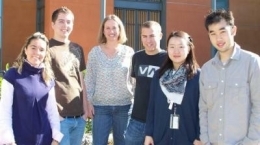
Name
Maria Marco, Ph.D.
Title
Assistant Professor of Food Science
Institution
University of California, Davis
Education
2002: Ph.D., University of California, Berkeley, Plant and Microbial Biology
1995: B.S., Pennsylvania State University, Microbiology
PHOTO:
DR. MARCO (THIRD FROM LEFT) IS JOINED BY LAB TEAM MEMBERS (L - R): ROCIO CASQUETE-PALENCIA, TOM WILLIAMS, BEN GOLOMB, BOKYUNG LEE AND ERIC LOW.
What brought you to the University of California, Davis?
Both my husband (Johan Leveau, Assistant Professor, Department of Plant Pathology) and I moved to Davis from the Netherlands last year. We were attracted to Davis because both of us could work at a prestigious university which is well-known for our fields of research. Having lived in California during my Ph.D. training, I was also quite excited to return to this naturally beautiful state with its amazing mountains, coastline and agricultural diversity.
How did you learn about the Center for Produce Safety? Why did you decide to apply for funding?
I heard about CPS shortly after arriving in Davis last autumn when I was notified by my Food Science colleague, Dr. Linda Harris, that CPS had announced a call for research. I applied because I am interested in performing research which adds to our basic understanding of microorganisms and is also relevant and applicable to the leafy greens industry. CPS offers this opportunity because it serves as a direct link between academic researchers and real industry needs.
CPS awarded funding to your project “Contribution of phyllosphere microbiota to the persistence of Escherichia coli O157:H7 ATCC 700728 on field‐grown lettuce.” First of all, what is a lettuce “phyllosphere”?
“Phyllosphere” refers to the aerial portions of lettuce, the parts exposed to air during growth.
And what are the key factors influencing this field of inquiry?
Decades of phyllosphere research have shown the amounts and diversity of microorganisms on plants can vary depending on plant species, season, and plant age. These studies have typically been based on culture-dependent methods of bacterial enumeration and identification. We now know from molecular analyses of this habitat that only small fractions of the total diversity of microorganisms in the phyllosphere have been cultivated in the laboratory. In my project, we are applying both traditional culturing techniques and modern culture-independent methods based on 16S rRNA gene identification which will allow us to fully address questions about which bacteria are present in the lettuce phyllosphere—and whether there are positive or negative correlations between these organisms and viable E. coli O157:H7.
What do you think the industry will gain from your research?
Environmental factors and abiotic stresses (moisture, nutrients, UV radiation, and temperature) are known to affect the ability of microorganisms, including human pathogens, to survive on lettuce. Much less understood is how the naturally-occurring bacteria (microbiota) colonizing plant surfaces might also affect pathogen survival in that habitat. I believe the industry will benefit from this project by our efforts to determine whether the lettuce phyllosphere microbiota is relevant for risk assessments of E. coli O157:H7 produce-associated outbreaks.
Five years from now, where do you see the field of food safety research?
I believe that due to the current significant interest within the food industry to ensure safe foods, microbial testing and early-warning systems will be coordinated and standardized for many food products. Additionally, the priorities between academic food safety research and industry needs will be highly aligned because while the need for innovative and fundamental research on human pathogens is increasing, so too are the demands on food industries to provide safer products.
Aside from working in the laboratory, how else do you spend your time?
I spend about 20% of my time in the lab, and the rest of my time teaching, writing, and working on committees. Outside of work, my family includes two boys, ages three and six. They are high-energy kids who constantly amaze me with their sense of wonder and imagination. We enjoy hiking and camping in the Sierras and along California’s beautiful coastline.
Lastly, what would you consider a career highlight?
Prior to moving to Davis in July of 2008, I worked in Wageningen- Ede, in the Netherlands, first as a postdoc and later as a project leader at a leading food research company, where I led projects directly funded by food companies. Because the results were being directly implemented by businesses, they are definitely among my career highlights. Another career highlight has been my promotion this past summer from Assistant Adjunct Professor to a tenure-track Assistant Professor position in the Food Science Department.